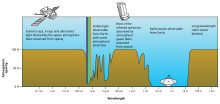
Back علم الفلك البصري Arabic Astronomia visible Catalan Optická astronomie Czech Visuelle Astronomie German Astronomía visible Spanish اخترشناسی نور مرئی Persian Optinen tähtitiede Finnish Astronomie optique French Optička astronomija Croatian Astronomia ottica Italian
This article needs additional citations for verification. (August 2018) |

Visible-light astronomy encompasses a wide variety of astronomical observation via telescopes that are sensitive in the range of visible light (optical telescopes). Visible-light astronomy is part of optical astronomy,[clarification needed] and differs from astronomies based on invisible types of light in the electromagnetic radiation spectrum, such as radio waves, infrared waves, ultraviolet waves, X-ray waves and gamma-ray waves. Visible light ranges from 380 to 750 nanometers in wavelength.
Visible-light astronomy has existed as long as people have been looking up at the night sky, although it has since improved in its observational capabilities since the invention of the telescope, which is commonly credited to Hans Lippershey, a German-Dutch spectacle-maker,[1] although Galileo played a large role in the development and creation of telescopes.
Since visible-light astronomy is restricted to only visible light, no equipment is necessary for simply star gazing. This means that it's the most commonly participated in type of astronomy, as well as the oldest.
- ^ King, Henry C. (2003). The History of the Telescope. Courier Corporation. p. 30. ISBN 978-0-486-43265-6.
© MMXXIII Rich X Search. We shall prevail. All rights reserved. Rich X Search